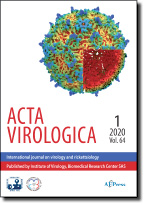Acta Virologica Vol.66, No.4, p. 339 – 351, 2022
|
| Title: An integrated view of protein homologue groups and functional genomic development of baculoviruses: towards understanding baculoviral infection mechanism and improving baculoviral expression vector |
| Author: Weiping Lin, Yanhua Shi, Tao Yu, Yujiao Wang, Yonglin Tan, Punan Zhao, Guohui Wang, Dianhai Hou |
|
Abstract: This study aimed to gain a comprehensive view of protein homologue groups of baculoviruses and elaborate the correlation between protein conversation and functional roles in the viral biphasic infection cycle. A comprehensive identification of homologue groups among 76 baculoviral genomes was performed, supplying a global view of the distribution of 992 homologue groups among baculoviruses. Fifty-six missed proteins from previous annotated genomes were added, updating AC76 as a new number found in all baculoviruses except Deltabaculovirus and the LEF 10 (AC53a) as a new number present in all the Alphabaculovirus and Betabaculovirus. Accompanied by an updated encyclopedia of functional genomic development, an integrated view of the correlation between protein conversation and functions was summarized for Autographa californica nucleopolyhedrovirus (AcMNPV). The AC106/107 and ODV-E18 were screened out as underestimated proteins and would need investigations on their detailed roles in viral infection cycle. A baculovirus-host network was constructed based on archive exploration, indicating that the ODV-E18 would be the core of viral interaction network. Further, potential functional domains and sites of ODV-E18 were further analyzed, supplying future research targets for exploring their detailed role in the regulation of the BV/ODV formation mechanism. This would facilitate further baculoviral genome annotation, functional genomic investigation and construction of a baculoviral minigenome that could be exploited as high-capacity expression vector
|
|
| Keywords: baculovirus; biphasic infection; baculoviral expression vector; phylogenomic; virus-host network |
|
|
Published online: 09-Dec-2022
|
| Year: 2022, Volume: 66, Issue: 4 |
Page From: 339, Page To: 351 |
doi:10.4149/av_2022_405
|
|
 download file download file |
|
|
|
|
 download file
download file
